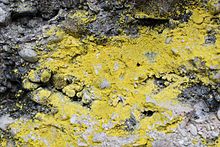
The Teloschistaceae are a large family of mostly lichen-forming fungi belonging to the class Lecanoromycetes in the division Ascomycota. The family, estimated to contain over 1800 species, was extensively revised in 2013, including the creation or resurrection of 31 genera. It contains four subfamilies: Brownlielloideae, Xanthorioideae, Caloplacoideae, and Teloschistoideae.

Amandinea is a genus of lichenized fungi in the family Caliciaceae. Genetic studies indicates that the genus Amandinea and Buellia are the same, although this is not widely accepted.
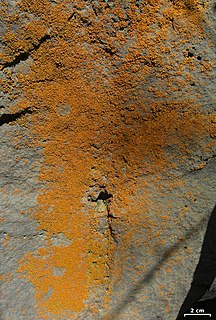
Xanthomendoza is a genus of small, bright orange foliose lichens with lecanorine apothecia. It is in the family Teloschistaceae. Members of the genus are commonly called sunburst lichens or orange lichens because of their bright orange color.

Candelaria is a genus of lichen-forming fungi in the family Candelariaceae. The genus was circumscribed by Italian lichenologist Abramo Bartolommeo Massalongo in 1852.

Absconditella is a genus of lichenised fungi in the family Stictidaceae. The genus was circumscribed in 1965 by Czech lichenologist Antonín Vězda, with Absconditella sphagnorum assigned as the type species. Absconditella is characterised by gyalectoid apothecia with a hymenium that is not amyloid, without a dark pigment and thalli containing green algae as photobionts. The genus name means "hidden", a reference to the scant structure of the thallus and its small apothecia.
Amundsenia is a genus of saxicolous lichens in the family Teloschistaceae. It has two species. The genus was circumscribed in 2014 by Isaac Garrido-Benavent, Ulrik Søchting, Sergio Pérez-Ortega, and Rod Seppelt, with A. austrocontinentalis assigned as the type species. The type is known only from continental Antarctica, while A. approximata occurs in the Arctic.
Austroplaca is a genus of lichen-forming fungi in the family Teloschistaceae. It has 10 species. The genus was circumscribed in 2013 by Ulrik Søchting, Patrik Frödén, and Ulf Arup, with Austroplaca ambitiosa assigned as the type species.

Athallia is a genus of fungi belonging to the family Teloschistaceae. It was first described in 2013 by Ulf Arup, Patrik Frödén, and Ulrik Søchting, and the type species is Athallia holocarpa. The genus name means without a thallus.
Bryoplaca is a genus of fungi belonging to the family Teloschistaceae.
Calogaya is a genus of fungi belonging to the family Teloschistaceae. This genus was first described in 2013 by Ulf Arup, Ulrik Søchting, and Patrik Frödén. The genus name of Calogaya is in honour of Dr. Ester Gaya, a Spanish Botanist from the University of Barcelona and the etymology prefix of Calo meaning 'spectacular'.

Flavoplaca is a genus of crust-like or scaly lichens in the family Teloschistaceae. It has 28 species with a mostly Northern Hemisphere distribution.

Xanthocarpia is a genus of mostly crustose lichens in the family Teloschistaceae. It has 12 species with a largely Northern Hemisphere distribution.
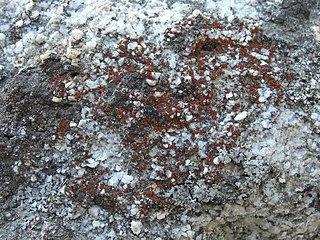
Rufoplaca is a genus of lichen-forming fungi in the family Teloschistaceae. The genus was circumscribed in 2013 by Ulf Arup, Ulrik Søchting, and Patrik Frödén.

Polycauliona is a genus of lichen-forming fungi in the family Teloschistaceae.
Pachypeltis is a genus of lichen-forming fungi in the family Teloschistaceae. The genus was circumscribed in 2013 by Ulrik Søchting, Patrik Frödén, and Ulf Arup.
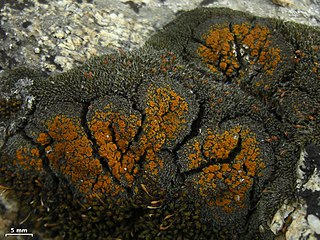
Parvoplaca is a genus of lichen-forming fungi in the family Teloschistaceae. The genus was circumscribed in 2013 by Ulrik Søchting, Patrik Frödén, and Ulf Arup.

Squamulea is a genus of lichen-forming fungi in the family Teloschistaceae. It has 15 species. The genus was circumscribed in 2013 by Ulf Arup, Ulrik Søchting, and Patrik Frödén, with Squamulea subsoluta assigned as the type species. Five species were included in the original account of the genus. The genus name alludes to the squamulose growth form of most of its species. Squamulea has a worldwide distribution; when the genus was originally created, the centre of distribution was thought to be in southwestern North America.
Dufourea is a genus of lichen-forming fungi in the subfamily Xanthorioideae of the family Teloschistaceae.
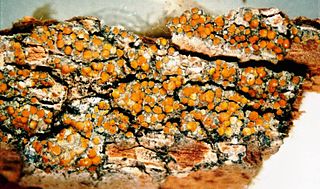
Cerothallia is a genus of crustose lichens in the family Teloschistaceae. It has four species, all of which occur in the Southern Hemisphere. The genus was circumscribed in 2013 by Ulf Arup, Patrik Frödén, and Ulrik Søchting, with Cerothallia luteoalba assigned as the type species. The type is more widely distributed, as it is also found in Europe and North America. The generic name Cerothallia means "with waxy thallus".
Sirenophila is a genus of crustose lichens in the subfamily Teloschistoideae of the family Teloschistaceae. It has four species with an Australasian distribution.
